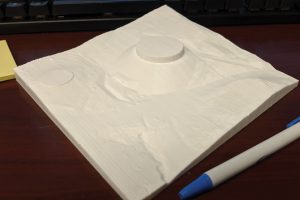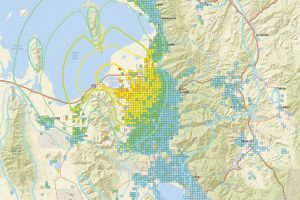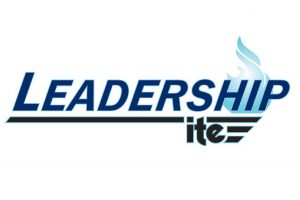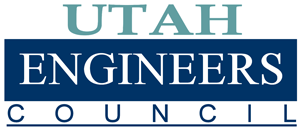Technology
When I was originally asked to speak, I thought I would talk about the U.S. Air Force’s YAL-1A Airborne Laser aircraft because it was the engineering marvel of its time. But this year’s theme for the annual UEC Banquet was “Imagining Tomorrow.” We celebrated the engineering scholarship recipients and people who are advancing within their professional societies, so I decided to talk instead about a little bit of the technology changes I’ve seen in my lifetime and where I think we are going.
The first row’s images (below) are about what has already happened during my lifetime. Typewriters, projectors, cameras and telephones all used to be separate devices. They were based on manual technology, such as large-scale video and digital formats, on individual equipment pieces. Now they have been replaced completely or partially by hand-held devices like cellphones, plus a lot of other functionality.
The second row’s images are about the future and the growing importance of artificial intelligence (AI). We already have many apps on our phones. Increasingly, they will be driven by AI that knows what you will want to do next. The apps will rapidly fuse information about things we know we want with things we didn’t know we want and then give us the results. For example, if someone calls me, one or more apps on my cellphone will know a call was on my calendar. It will know the purpose of the call; as a result, it might open a bio and a slide deck and then transcribe the conversation. If I refer to something, the app could inject the reference’s internet link into the printed text or open an example of that reference on both of our devices for us both to see.
By the way, the image on the bottom right is wrong. I wanted a picture of a human hand holding a world, but the only picture I could find was of a robot hand instead. Humans can and will stay “in the loop” as need as a check-and-balance on the information. In my opinion, the challenge will be to keep the human unbiased with respect to the appropriate data to access, review, or modify, rather than keeping the machine from overreaching.
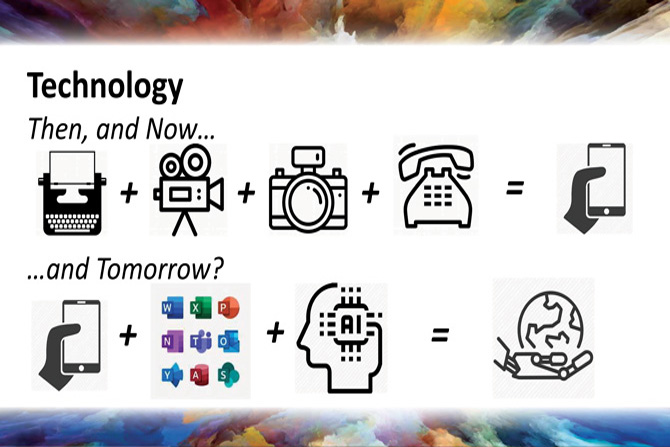
Systems Engineering
The graphic shows how the Air Force-defined system engineering processes and technical management processes are aligned and organized as part of the well-known systems engineering “vee” diagram. On a practical level, whether professionally or personally, we are all system engineers because we all manage systems. That includes us, our spouses or partners, and our children. We all make decisions and manage risks. Everyone thinks at least informally about requirements, including why the requirements are there and what the requirements mean, whether designing a building or setting up a home or business.
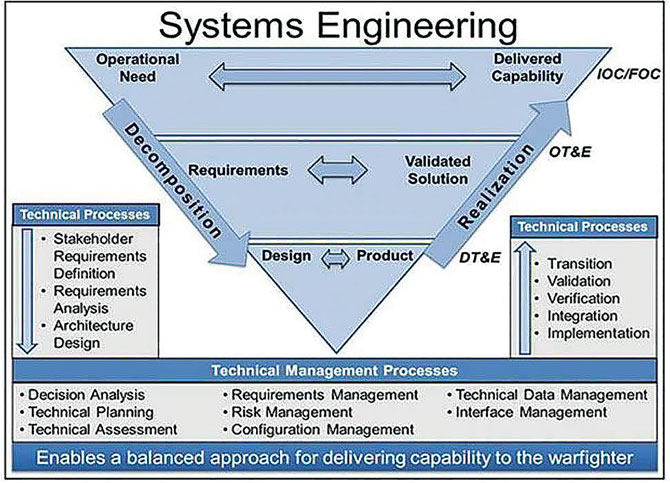
Model-based Systems Engineering
Systems engineers are now frequently engaging with model-based systems engineering. What does it mean to be doing model-based systems engineering? This form of engineering organizes engineering data and processes it within descriptive models.
These system models are large relational databases that are related to analysis tools. They capture requirements, risk, schedule and costs. Analysis tools take model information and analyze it, then create estimates and simulations. The system models, or architectures, contain more information than the “traditional” design-focused physical engineering model.
Analytical tools (red circle, bottom left) are changing faster than the models themselves (blue circle, top). Models and tools are fed by or archived in a data lake or data storage (yellow circle, bottom right). The models are always available through data management processes, analytical tools, and the inputs and outputs of analysis. The arrows between the circles show these critical integrating functions.
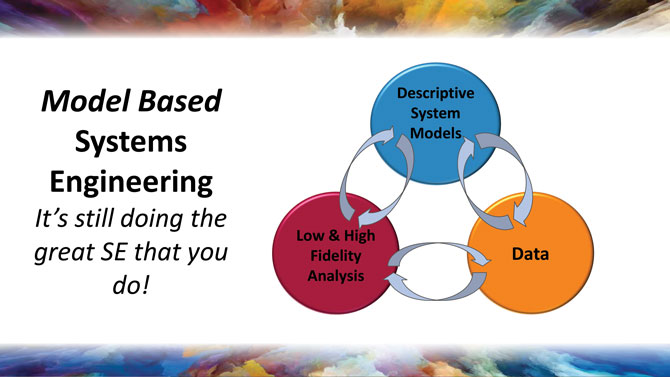
Digital Engineering (Versus MBSE)
Model-based system engineering sounds good in theory, but it’s only useful in reality if you can access the data, models, and tools. Digital engineering mainly describes where that access takes place. It involves a hardware and software infrastructure where the IT experts behind the engineers define and implement the kinds of secure networks and efficient processors needed to do this computationally intensive work. When you have a lot of data, digital engineering helps organize it into models and analyze it rapidly to make decisions for designing, manufacturing, or sustaining.
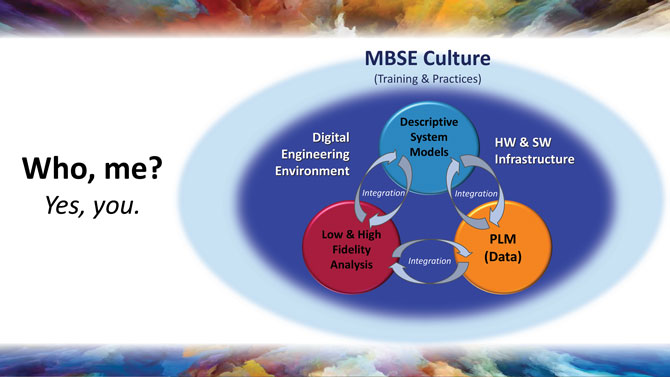
MSBE Culture
Everybody needs to get comfortable with digital engineering to the same degree as we are comfortable with software suites like Microsoft Office.
In the new model-based environment, where we have radical data integration and radical data availability, access will be nearly as transparent as using an app in Microsoft Office. In a model-based environment, we are already seeing models that capture and contextualize data almost transparently.
The process is already happening in the cloud — hence the graphic is “fuzzy” around the edges for a reason. The cloud can make data available to anyone anywhere through virtual machines. All you need to access data through a portal is a device and the right security controls.
The device’s computational burden is “thin.” You don’t have a lot of computing power on your desktop or portable device because the computing power is in the cloud, and that is where the majority of the work occurs. The information generated and stored in the cloud then flows to us as decision-makers.
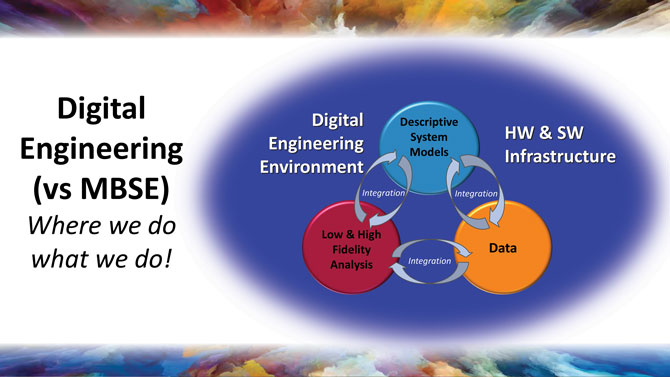
But I’m Sustaining Something Old!
I’ve been interested in model-based engineering at a design level and model-based systems engineering processes at a higher level for over 20 years because I saw how useful it was to have a digital twin when managing a program like the Airborne Laser.
Model-based systems engineering processes and their digital engineering infrastructure can apply to wherever you are in a product lifecycle. When you design, build, manufacture, sustain or update something, you either have an object in hand to operate and maintain or requirements for the work to be done. There is a great benefit to capturing information about your work early as you design and acquire a product. For example:
- Captured data allows you to test and evaluate so you know if an object will work when it is manufactured.
- If the object has already been built, you can make good decisions about updating or scrapping it.
- Models help you do performance simulations and run cost analyses. They help you manage the cost, schedule, and performance of any item designed, built or sustained.
One of the breakthroughs on the airborne laser project I worked on involved the required modifications to the Boeing 747 aircraft chosen to carry the system. We had to transition the paper-based design to a three-dimensional computational model because we took a 747 off the assembly line, basically took it apart, and rebuilt it in a highly modified way around the laser component.
The work involved was massive, but we did the digital parts first. We had data about pipes, conduits, chemical tanks, and electronics, and we made it all fit. We tracked cost, the weight of the airplane’s modifications, and performance assessments. We wanted to know whether the 747 testbed could generate enough energy to propagate a laser as far as the Air Force wanted it to, with the required accuracy. The “digital twin” helped plan and execute this work to eventually reach a successful missile shoot-down test.
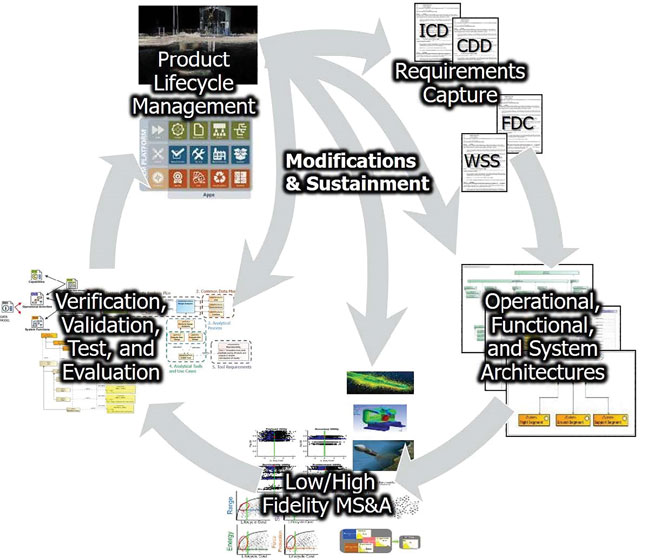
But I’m Not a Systems Engineer
I used the same picture here as on the previous section because all engineering disciplines can benefit from organizing data into models and aligning models against analytical tools. The tools change faster than the models, so engineers can use models to organize and analyze their data, then change the model content if the analytics dictate it. The models also enable improved integration with other engineering disciplines, keeping all subject matter experts referencing the same source of technical truth.

So, What About Tomorrow?
What does this presentation mean to you practically? I propose a few specific areas for you to think about, and then go help advance the state of the art!
Legacy Data Migration
Migrating legacy data is very expensive. It requires time and investment in digital engineering infrastructure, especially if your starting point is completely paper and you want to create a detailed model from it.
The most important things to model early are those that represent high risk. For example, you should focus on modeling relationships, dependencies, interfaces, and aspects of the design that are most likely to change. As soon as you can complete even a partial model, it can help others execute their technical or program management responsibilities.
Mixed Reality
Virtual reality, or augmented reality, gives you the ability to immerse yourself in the data so you can understand it and how it interacts. The results can put modeling and simulation “on steroids”! For example, television shows like Star Trek showed us a holodeck where a simulation surrounded the actors. Other shows and movies have screens that can be pulled up and used by a hand gesture.
These applications are becoming more and more available and practical. It is already possible to be surrounded by a simulation that isn’t just on a screen in front of you. You will be able to see how a very complicated system operates. You will also be able to examine a simulated object inside and out. Instead of being fixed in a cockpit, for example, you could go into an airplane wing and see how a hydraulic actuator is moving in flight and immediately see the impact on a change in design or in the system’s operation.
There are very practical applications for mixed reality. Engineering used to be more about the operator and how the operator was going to interact. Engineering now is about system performance with or without the operator, and that’s the direction the simulations are going. The work has become more concerned about the system itself.
Practical applications of a data-intensive, model-based environment are fairly self-explanatory. In a model-based world, you use system information to make products such as a Tesla sedan better and safer. The engineer is always looking ahead and uses the model-based environment to make continual process and product improvements.
Operating Locations
Engineers, from wherever they happen to be, can access data from many different operating locations. The pandemic has accelerated the process.
The Cloud
Information is ideally shared by a group of people who make decisions, but data growth has created the need for more intensive “data democratizing” capabilities.
Of course, cloud security has become increasingly important. If radically comprehensive and collaborative data exists, then your adversary or your competition can get a hold of it as well. Facebook has shown us how hard it is to keep private data safe.
Good data management and cybersecurity processes can ensure that people only see what they need to know.
Rapid Virtual Prototyping
The model-based world makes good engineers great and great engineers epic because they can see, comprehend, and act on so much data. They can look ahead, manage risks, see how to modify their work, and make and support decisions.
For example, an “Iron Man” exoskeleton suit allows you to do inhuman feats. In that same vein, we will have AI for data access on the same level as Tony Stark’s AI system, Just a Rather Intelligent System (JARVIS), and we will be able to call up simulations very rapidly. For example, someone wearing a holo lens will be able to reach out and take apart a virtual system or look at its supply chain history.
We currently do physical testing when we want to validate and verify the models. As our skill increases, we will need to do much less physical prototyping and testing, just as NASA moved from having mathematicians like Katherine Johnson do calculations by hand to using actual computers instead.
Mathematicians continued to verify computations manually until NASA trusted computer accuracy. The same will be true for virtual simulations. We test when we need to anchor the model. The model drives simulations, but the simulations will become more powerful, and we will trust them more. Large virtual testing evaluations will become more common, and as it does, we will build fewer wind tunnels and test tracks. We will do fewer risky and expensive full-scale tests.
Just Imagine … and then, MAKE IT HAPPEN!
Data organized into models will be accessible to data tools, but this presentation about the expanding role of models and AI in engineering just scratched the surface. We will never reach a finish line, and the work currently being done — and your future work using these processes and technologies — is expanding human innovation. Go forward and innovate!







